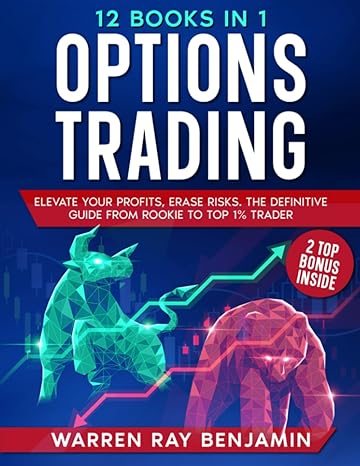
Help answer question 3 in it's entirety.
We have discussed many concepts in SCM 301 related to planning, sourcing, making and delivering products and services. The purpose of this case analysis is to integrate relevant elements of the course and to apply tools you have learned to help evaluate supply chain performance. Consider yourself a summer intern and your assignment is to put what you learned in SCM 301 to good use helping the Throx company evaluate its current supply chain practices. You are tasked with evaluating the company's recent performance and making decisions and recommending changes to improve supply chain performance. The questions that you are required to answer are included in the second half of this document. Company Background Information Throx sells higher-end custom-design socks in three-sock sets (rather than the customary two sets). The company operates from a small packaging and distribution facility in Richmond, CA from which it ships product to customers. Given the company's location and focus, 97% of sales are in California, primarily in the major urban areas of the San Francisco bay area, Los Angeles, Sacramento, and last but not least San Diego. The company sells exclusively via online sales, at an average price of $20/ threesock set, plus shipping costs charged to the customer. The company currently orders its product from the Chinese sock manufacturer Zhejiang Datang Hosiery Group Co., Ltd in so-called "Sock City." Socks are transported from the factory via truck to the port of Shanghai, from where they are shipped to the port at LA-Long Beach via ocean freight. Once offloaded at the port of LA-Long Beach, the socks are then shipped via truck to the Richmond facility. On average, shipping time from the manufacturer to the Richmond facility takes 4 weeks. In addition to the transit time required for shipment, the lead time from when an order is placed with the manufacturer to when it is shipped from Zhejiang is 3 weeks. So, the total lead time is considered to be 7 weeks from when Throx places an order until it reaches the Richmond facility. Historically, the standard deviation of total lead time has been 1.5 weeks. Product Orders (Demand) Information The company provides you with the following information for the past two fiscal years: Product Forecasting Information Throx uses two main forecasting methods based on annual data to predict orders for the following year, a weighted moving average and exponential smoothing. The table below provides forecast calculations for FY2017 through FY2020, along with actual demand experienced in each of those years. Weighted Moving Average uses Wt=0.6,W11=0.2,W1.2=0.2 Exponential Smoothing uses =0.9 and 1=0.1 - Order cost to throx for an order placed with its current supplier, $/ order =$=$300 - Holding cost per set per year =H=$2.25 - The company currently pays (P) $8.00 for each set of socks The company uses a continuous review replenishment policy and has it systems in place that allow constant monitoring of key information. Last year, the company used a ROP under this policy of 2,000 units for all sock styles and an order quantity (Q) of 5,000 units for all sock styles. Potentiol Alternatives to Current Supply Chain Management The company has asked you to evaluate a number of alternatives to their current SCM practices. including at a minimum their choice of supplier, transportation modes, order quantities and safety stock, and warehouse capacity and location. Supplier Information The table below provides information relating to important characteristics of the current supplier. In addition, the table includes the same types of information for two potential alternative suppliers in China (A and B ) that have been contacted by Throx. The last column indicates the weights to be considered for each supplier characteristic. * TBD= to be determined (calculated) by students Quality Performance Information To conduct a quality performance assessment for each of these suppliers, Throx would like you to determine the value of the Capability Index (Cpk) for each. The table below includes information that will facilitate this analysis. Also, Throx has set a Target Sock Thickness: 7mm+/.5mm. Transportation Information Similar to the changes that have been contemplated with regard to product sourcing, Throx would like to use a single-sourcing strategy for transportation. As an alternative to their current use of Maersk Ocean Freight, Throx would like to consider UPS AirExpress which would significantly reduce actual shipping time from Shanghai to Richmond. The table below provides information for evaluating a potential change of shipping from ocean to air. - No data is available about variation in transit times for air, so Throx assumes this is constant. NOTE: Ignore any current port capacity issues when making your decision/recommendation. Warehouse Location Information The company would also like to assess whether its current warehouse location is appropriate based on where customers are located. For each of the key markets served by Throx, the table below indicates recent population figures and X and Y coordinates of the market locations. Sales of Throx products in each location is roughly proportional to the size of the population. For this question you will need to calculate 2 different EOQ and ROP values and interpret the results. For both EOQ and ROP, give your final answer in full sock sets (ROUND UP to the next whole number). The specific questions to answer are indicated in items a, b, and c below. Additional tips to calculate the EOQ and ROP are provided in the bullet points that follow. a) Calculate EOQ and ROP for FY2020 based on the FY2020 forecast value that you determined to be most accurate in Question \#1. b) Calculate the EOQ and ROP based upon actual demand for FY2020 c) Use the total inventory cost calculation to determine total inventory costs for each of the three EOQ results: EOQ from part a, EOQ from part b, and the Q that Throx is currently using (given in the case). When determining the costs use 2020 actuals for: your Demand (D) for all three scenarios. 1. Compare the total inventory costs from the three results and analyze what this shows you. ii. What are the implications of the ROP Throx is currently using versus the ROP based on Actual Demand? Additional tips: - Use a service level of 95%(z=1.65) when calculating the ROP. - For the standard deviation of weekly demand, use the data provided in the table on page 2 of the case with the FY2020 forecast for all approaches. - Annual Inventory management costs will include the following: Annual Holding Costs, Annual Ordering Costs, and Purchase Cost. We have discussed many concepts in SCM 301 related to planning, sourcing, making and delivering products and services. The purpose of this case analysis is to integrate relevant elements of the course and to apply tools you have learned to help evaluate supply chain performance. Consider yourself a summer intern and your assignment is to put what you learned in SCM 301 to good use helping the Throx company evaluate its current supply chain practices. You are tasked with evaluating the company's recent performance and making decisions and recommending changes to improve supply chain performance. The questions that you are required to answer are included in the second half of this document. Company Background Information Throx sells higher-end custom-design socks in three-sock sets (rather than the customary two sets). The company operates from a small packaging and distribution facility in Richmond, CA from which it ships product to customers. Given the company's location and focus, 97% of sales are in California, primarily in the major urban areas of the San Francisco bay area, Los Angeles, Sacramento, and last but not least San Diego. The company sells exclusively via online sales, at an average price of $20/ threesock set, plus shipping costs charged to the customer. The company currently orders its product from the Chinese sock manufacturer Zhejiang Datang Hosiery Group Co., Ltd in so-called "Sock City." Socks are transported from the factory via truck to the port of Shanghai, from where they are shipped to the port at LA-Long Beach via ocean freight. Once offloaded at the port of LA-Long Beach, the socks are then shipped via truck to the Richmond facility. On average, shipping time from the manufacturer to the Richmond facility takes 4 weeks. In addition to the transit time required for shipment, the lead time from when an order is placed with the manufacturer to when it is shipped from Zhejiang is 3 weeks. So, the total lead time is considered to be 7 weeks from when Throx places an order until it reaches the Richmond facility. Historically, the standard deviation of total lead time has been 1.5 weeks. Product Orders (Demand) Information The company provides you with the following information for the past two fiscal years: Product Forecasting Information Throx uses two main forecasting methods based on annual data to predict orders for the following year, a weighted moving average and exponential smoothing. The table below provides forecast calculations for FY2017 through FY2020, along with actual demand experienced in each of those years. Weighted Moving Average uses Wt=0.6,W11=0.2,W1.2=0.2 Exponential Smoothing uses =0.9 and 1=0.1 - Order cost to throx for an order placed with its current supplier, $/ order =$=$300 - Holding cost per set per year =H=$2.25 - The company currently pays (P) $8.00 for each set of socks The company uses a continuous review replenishment policy and has it systems in place that allow constant monitoring of key information. Last year, the company used a ROP under this policy of 2,000 units for all sock styles and an order quantity (Q) of 5,000 units for all sock styles. Potentiol Alternatives to Current Supply Chain Management The company has asked you to evaluate a number of alternatives to their current SCM practices. including at a minimum their choice of supplier, transportation modes, order quantities and safety stock, and warehouse capacity and location. Supplier Information The table below provides information relating to important characteristics of the current supplier. In addition, the table includes the same types of information for two potential alternative suppliers in China (A and B ) that have been contacted by Throx. The last column indicates the weights to be considered for each supplier characteristic. * TBD= to be determined (calculated) by students Quality Performance Information To conduct a quality performance assessment for each of these suppliers, Throx would like you to determine the value of the Capability Index (Cpk) for each. The table below includes information that will facilitate this analysis. Also, Throx has set a Target Sock Thickness: 7mm+/.5mm. Transportation Information Similar to the changes that have been contemplated with regard to product sourcing, Throx would like to use a single-sourcing strategy for transportation. As an alternative to their current use of Maersk Ocean Freight, Throx would like to consider UPS AirExpress which would significantly reduce actual shipping time from Shanghai to Richmond. The table below provides information for evaluating a potential change of shipping from ocean to air. - No data is available about variation in transit times for air, so Throx assumes this is constant. NOTE: Ignore any current port capacity issues when making your decision/recommendation. Warehouse Location Information The company would also like to assess whether its current warehouse location is appropriate based on where customers are located. For each of the key markets served by Throx, the table below indicates recent population figures and X and Y coordinates of the market locations. Sales of Throx products in each location is roughly proportional to the size of the population. For this question you will need to calculate 2 different EOQ and ROP values and interpret the results. For both EOQ and ROP, give your final answer in full sock sets (ROUND UP to the next whole number). The specific questions to answer are indicated in items a, b, and c below. Additional tips to calculate the EOQ and ROP are provided in the bullet points that follow. a) Calculate EOQ and ROP for FY2020 based on the FY2020 forecast value that you determined to be most accurate in Question \#1. b) Calculate the EOQ and ROP based upon actual demand for FY2020 c) Use the total inventory cost calculation to determine total inventory costs for each of the three EOQ results: EOQ from part a, EOQ from part b, and the Q that Throx is currently using (given in the case). When determining the costs use 2020 actuals for: your Demand (D) for all three scenarios. 1. Compare the total inventory costs from the three results and analyze what this shows you. ii. What are the implications of the ROP Throx is currently using versus the ROP based on Actual Demand? Additional tips: - Use a service level of 95%(z=1.65) when calculating the ROP. - For the standard deviation of weekly demand, use the data provided in the table on page 2 of the case with the FY2020 forecast for all approaches. - Annual Inventory management costs will include the following: Annual Holding Costs, Annual Ordering Costs, and Purchase Cost
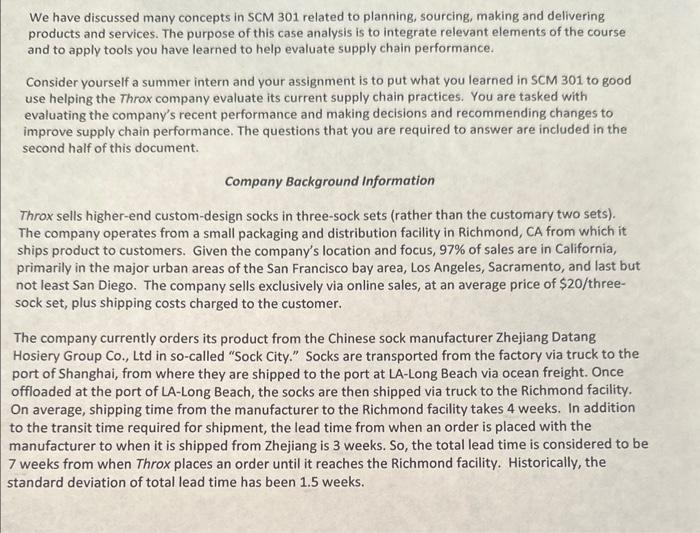
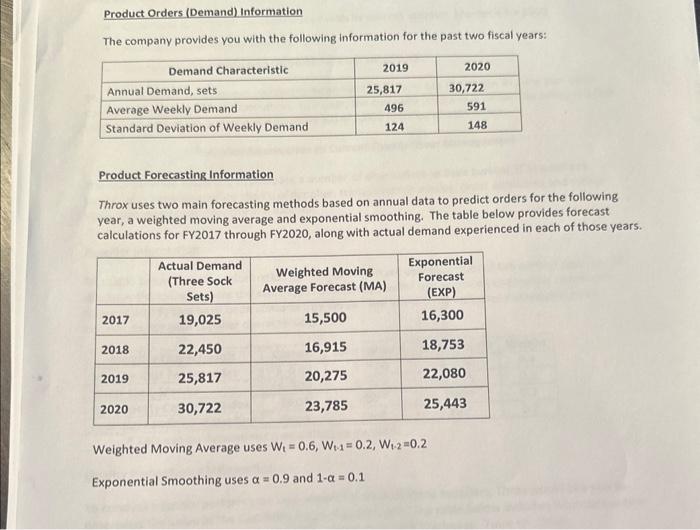
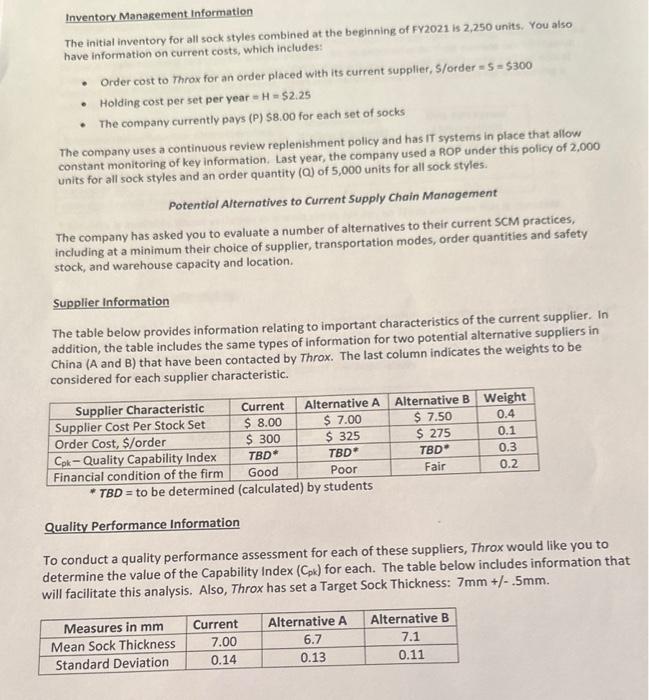
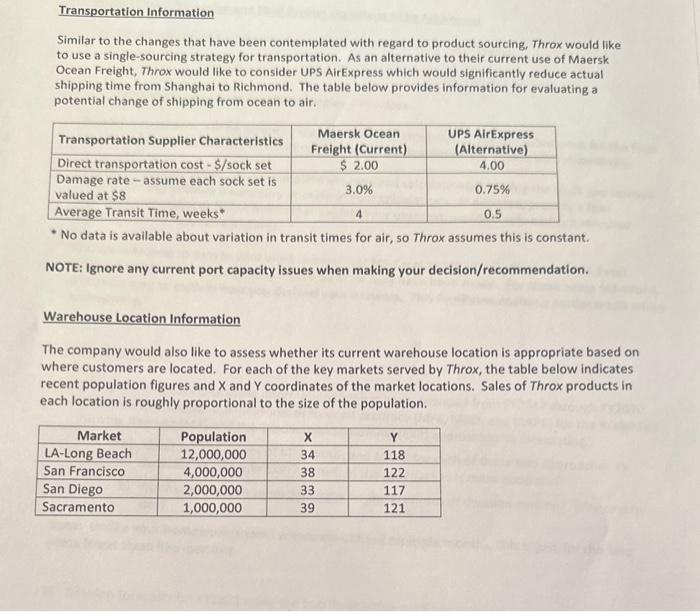
 Help answer question 3 in it's entirety.
Help answer question 3 in it's entirety. 





